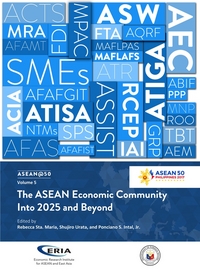- ABOUT ASEANThe Association of Southeast Asian Nations, or ASEAN, was established on 8 August 1967 in Bangkok, Thailand, with the signing of the ASEAN Declaration (Bangkok Declaration) by the Founding Fathers of ASEAN: Indonesia, Malaysia, Philippines, Singapore and Thailand. Brunei Darussalam joined ASEAN on 7 January 1984, followed by Viet Nam on 28 July 1995, Lao PDR and Myanmar on 23 July 1997, and Cambodia on 30 April 1999, making up what is today the ten Member States of ASEAN.Menu
- WHAT WE DO
ASEAN organs always strive to achieve ASEAN’s goals and objectives, the Secretary-General of ASEAN and the ASEAN Secretariat shall be functioned as coordinating Secretariat to help facilitate effective decision-making withing and amongst ASEAN bodies. In addition, each Member State shall appoint a Permanent Representative to liaise with Secretary-General of ASEAN and the ASEAN Secretariat
Menu - WHO WE WORK WITH
ASEAN shall develop friendly relations and mutually beneficial dialogues, cooperation and partnerships with countries and sub-regional, regional and international organisations and institutions. This includes external partners, ASEAN entities, human rights bodies, non-ASEAN Member States Ambassadors to ASEAN, ASEAN committees in third countries and international organisations, as well as international / regional organisations.
Menu - OUR COMMUNITIES
The rodmap for an ASEAN Community (2009-2015) was declared by the leaders in 2009. The ASEAN Community, anchored on three community pillars: Political-Security Community, Economic Community, Socio-Cultural Community was launched in 2015. The ASEAN 2025: Forging Ahead Together was introduced in 2015 as a Post-2015 Vision. It comprises the ASEAN Community Vision 2025, the ASEAN Political-Security Community Blueprint 2025, the ASEAN Economic Community Blueprint 2025 and the ASEAN Socio-Cultural Community Blueprint 2025
Menu - SITEMAP
The ASEAN Economic Community Into 2025 and Beyond
Author:Rebecca Sta. Maria, Shujiro Urata, and PoncianoS. Intal, Jr.

Abstract
ASEAN has successfully promoted economic integration by increasing intra-ASEAN trade and investment over 5 decades. This is despite the diversity of its member states in terms of the stages of economic development, political systems, ethnicities, and cultural backgrounds, thereby contributing to rapid economic development and growth. Progress in economic integration is realised through step-by-step confidence-building approach - or ASEAN way - towards integration by adopting various ASEAN-wide schemes including the ASEAN Free Trade Area in 1993 and ASEAN Economic Community (AEC) in 2015. Looking to the future, ASEAN needs to undertake investment actively, increase productivity, and enhance connectivity to continue and accelerate economic growth and to realise sustainable and inclusive economic growth. Towards this end, the papers in this volume elaborate on several critical policy measures for moving the AEC forward into 2025 and beyond: promotion of seamless trade facilitation, managing rising non-tariff measures, reframing trade service sector development and liberalisation, institutionalisation of good regulatory practice, enhancing connectivity and participation in global value chains, promoting innovation, and others. The papers effectively sharpen the logic and deepen the insights for the above-mentioned policy measures which are identified and presented in the AEC 2025 Blueprint and other ASEAN blueprints. In addition, the volume emphasises that effective and speedy implementation of these measures by ASEAN and ASEAN Member States requires not only strong political will/commitment but also a monitoring and evaluation system that engenders deep engagement of and collaboration with the business community, think tanks and research institutes, and civil society for constructive feedback.
More Details
| Author | Rebecca Sta. Maria, Shujiro Urata, and PoncianoS. Intal, Jr. |
| Barcode | <000000001624> <000000001625> <000000003008> <000000011050> <000000011050> |
| Edition | |
| Place | Jakarta, Indonesia |
| Publisher | Economic Research Institute for ASEAN and East Asia |
| Year | 2017 |
| Classification | Economic - ASEAN Economic Minister Meeting (AEM) |
| Call Number | 200 Ase |
| ISBN | 9786025460005 |
| Language | English |
| Content Type | Text Book |
| Media Type | printed |
| Number of copies | 3 |










